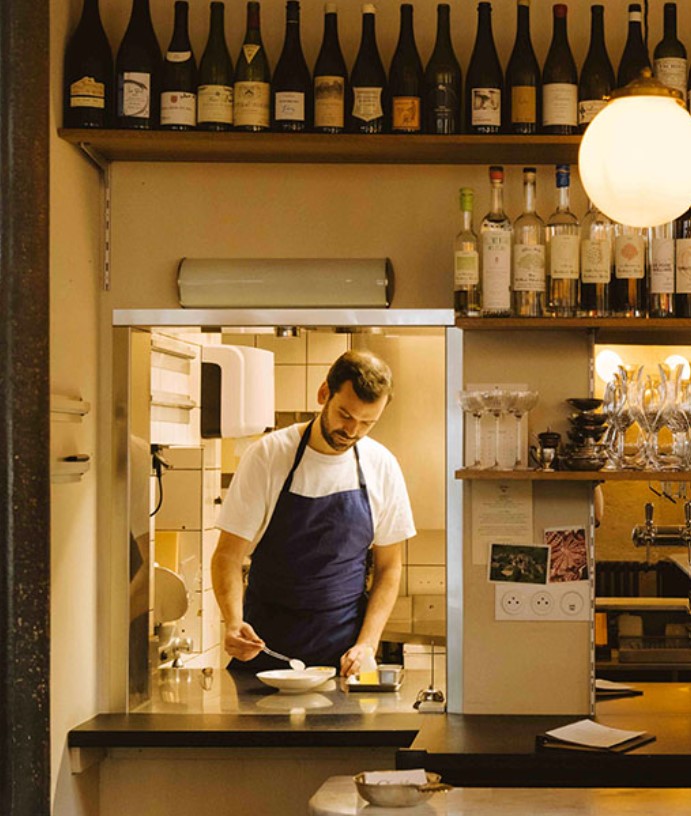“My favourite childhood memory of Chinese New Year is that of my mother preparing food every second day of the new year. She would start the day by going to the temple to give thanks to the deities, before specially making a trip the wet market to purchase a few chickens,” reminisces Cheung Siu Kong, the executive chef of one-Michelin-starred Summer Pavilion at the Ritz-Carlton Singapore. “I really miss the tang yuan (glutinous rice balls) soup that my mum would make from the chicken stock; most tang yuan are sweet, but my mother’s chicken soup tang yuan is savoury, which made them very unique.” Memory of the flames warming up the tangyuan soup is forever etched into his mind.
Though he was brought up in a humble family, the reunion dinners in the Cheung household were always extra lavish. Taking in the aromas arising from a table replete with home-cooked delicacies has become Chef Cheung’s most cherished Chinese New Year memory.
“Because we weren’t very well off then, we rarely got to enjoy such edible treats, so Chinese New Year was always a highly anticipated exception,” he shares. “After her prayers, my mother would start preparing her signature poached white chicken with ginger. She would hand-slice the garlic, and with a little oil and some salt added in, it would accentuate the freshness of the chicken.”
To the remaining stock from the poached chicken, Mrs Cheung would add the globules of handmade tang yuan, and a little celery and garlic - both symbols of good luck.
“Celery signifies a wish for diligence in young children; and the Chinese word for garlic is phonetically similar to the Chinese word ‘to count’, so the addition of garlic is akin to hoping for an abundance of blessings to count in the new year,” Chef Cheung explains.

“After I became a chef, my Chinese New Years have always been especially busy - and the restaurant’s kitchen a battleground. Every year we head into the festive season all ready for war, and no matter how busy it gets, we always survive,” chef Cheung laughs. “But once we’ve completed all our kitchen tasks, I usually invite a few colleagues and business partners to my home to catch up over a meal. After all, many of us in this profession spend more time in the kitchen than at home our own family, so it’s only right that we gather and celebrate as a work family. Singaporeans love their yu sheng (raw fish salad) and their pen cai, so I make sure I have that on the table, along with some poached chicken and roast meats. It’s a real feast!”
His favourite Chinese New Year delicacy? Pen cai, a bowl of carefully braised seafood filled with ingredients that bear auspicious significance for the year ahead.
Of all the legends surrounding the origins of pen cai, there is one that chef Cheung finds most interesting. The tale dates back to the final year of the Song Dynasty, when the emperor and his subordinates fled to the area around Hong Kong. When the villagers saw their arrival, they pooled together their best ingredients, cooked them and, because they didn’t have enough plates available, ended up serving them in large wooden basins to the emperor and his troops.
“Since then, people would serve pen cai to mark celebratory occasions, and as people got more prosperous, the ingredients would also get more luxurious and include delicacies such as abalone, dried black moss, dried oysters and braised goose feet - each one symbolising positive hopes for wealth, laughter or good health in the coming year,” Chef Cheung relates.
One of the most popular dishes at Summer Pavilion, pen cai is also a personal favourite of Chef Cheung when it comes to entertaining at home.

To complete the feast, Chef Cheung would crack open a bottle of Hennessy XO. Crafted by Maurice Hennessy as a drink meant for sharing with friends way back in 1870, the spirit contains a blend of over 100 eaux de vies which are nurtured in oak barrels – a time-tested process that, like Chinese New Year traditions, has remained unchanged since its creation.
Now that he has his own family, gathering around the table for Chinese New Year has become all the more important for Chef Cheung.
“Harmony is most important in a family. We’re all so busy with our daily schedules - the kids are in school and the adults have to go to work - but to have everyone set all our commitments aside to share a meal together, to laugh over anecdotes from our day or swap travel stories that is what matters the most to me,” he says.
“Here’s wishing everyone plenty of happiness, prosperity, good health and an abundance of wealth in the Year of the Chicken!”
More on Hennessy
Hennessy is a cognac distillery founded in 1765 by Richard Hennessy, an Irishman and former officer in the King of France's army. His know-how has been passed down for 250 years and elevated to an elegant art form that rests on three concepts: careful selection of the eaux-de-vie, its maturation as well as blending.
The Hennessy X.O featured in the video is a robust amber cognac with peppery and wild cocoa notes softened by dried and preserved fruits. On the palate, it is richly textured and appreciated equally with ice or a splash of sparkling or still water.
Exclusive for Michelin Guide Singapore Digital readers: Experience the magic of Hennessy's sharing spirit and bring home a bottle at preferential rates. Get more details here.






















